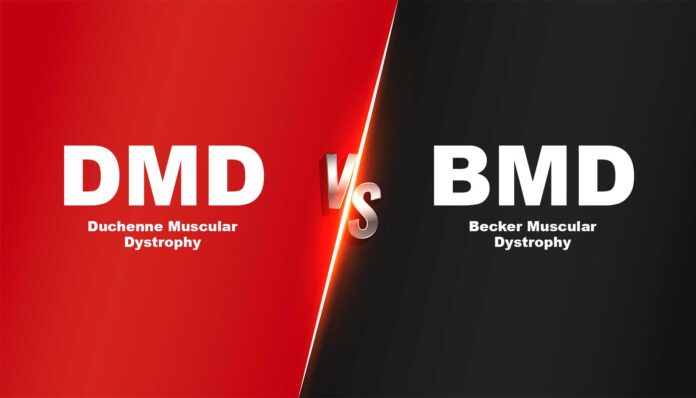Duchenne Muscular Dystrophy (DMD) and Becker Muscular Dystrophy (BMD) are both genetic disorders that affect the muscles, causing progressive weakness and wasting, but they differ in several key aspects, including the severity of symptoms, the age of onset, and the underlying genetic causes. Despite sharing this common genetic origin, there are key differences between the two conditions. Lets discover differences between DMD and BMD.
Table of Contents
Differences Between DMD and BMD

Genetic Cause
Duchenne Muscular Dystrophy (DMD):
- Caused by mutations in the dystrophin gene (located on the X chromosome).
- These mutations lead to a complete absence of dystrophin, a protein that helps maintain the integrity of muscle cells.
Becker Muscular Dystrophy (BMD):
- Also caused by mutations in the dystrophin gene, but these mutations typically result in a partially functional dystrophin protein.
- The dystrophin present in BMD is often shorter or less effective, but still somewhat functional.
Age of Onset
DMD:
- Symptoms typically appear in early childhood, often between 2 to 5 years of age.
- Early signs include difficulty walking, running, or climbing stairs.
BMD:
- Symptoms generally appear later than DMD, often during adolescence or in the early 20s.
- The onset can be more gradual and subtle compared to DMD.
Disease Progression
DMD:
- Disease progression in DMD is rapid and severe. Most children lose the ability to walk by the age of 12.
- It leads to severe cardiac and respiratory complications that can shorten life expectancy, with many affected individuals living into their late teens or early 20s.
BMD:
- BMD progresses more slowly than DMD.
- Individuals may retain the ability to walk into their 30s or 40s, and the severity of muscle weakness is generally less pronounced.
- Life expectancy is often normal or near normal, though some may develop heart or respiratory issues later in life.
Muscle Weakness
DMD:
- The muscle weakness in DMD is often severe and affects proximal muscles (those closer to the center of the body), such as the hips, thighs, and shoulders.
- This weakness leads to poor posture, difficulty standing up, and difficulty walking.
BMD:
- Muscle weakness in BMD tends to be less severe than in DMD, and it progresses more slowly.
- Similar muscles are affected, but the degree of weakness is usually milder.
Dystrophin Levels
DMD:
- There is no detectable dystrophin in the muscles due to a complete lack of the protein.
BMD:
- There is some dystrophin present, but it is defective or insufficient. The amount and functionality of the dystrophin determine the severity of the disease.
Cardiac and Respiratory Involvement
DMD:
- Cardiac (heart) and respiratory (lung) complications are common in DMD and tend to become problematic as the individual ages.
- Cardiomyopathy (heart muscle weakness) and respiratory failure often contribute to premature death.
BMD:
- Cardiac issues, especially cardiomyopathy, are also seen in BMD, but they are usually less severe and develop later in life.
- Respiratory issues can also occur, but they typically emerge later than in DMD.
Life Expectancy
DMD:
- Life expectancy is typically around 20-30 years, with many individuals passing away in their late teens or early 20s due to heart or respiratory complications.
BMD:
- Life expectancy is generally normal or near normal due to the slower progression of the disease and milder symptoms, though cardiac and respiratory problems can still lead to complications later in life.
Diagnosis
- Both conditions can be diagnosed through genetic testing (which identifies mutations in the dystrophin gene) or muscle biopsy (to check for dystrophin levels).
- DMD is usually diagnosed earlier because of its earlier onset and more severe symptoms.
- BMD may be diagnosed later because of its milder and slower progression.
Summary of Differences
| Feature | Duchenne Muscular Dystrophy (DMD) | Becker Muscular Dystrophy (BMD) |
|---|---|---|
| Cause | Complete absence of dystrophin | Partial or defective dystrophin |
| Onset | 2-5 years old | Adolescence to early 20s |
| Progression | Rapid and severe | Slower and milder |
| Muscle Weakness | Severe, affects proximal muscles | Milder, slower progression |
| Dystrophin levels | No dystrophin | Some defective dystrophin present |
| Cardiac/Respiratory | Early, severe complications | Later, milder complications |
| Life Expectancy | Shortened (early 20s) | Normal or near normal |
In essence, DMD is the more severe form with an earlier onset, while BMD is milder and progresses more slowly, often allowing for a longer life expectancy.
Learn More: Which exon skipping therapy is right for my son?




[…] What are The Differences Between Duchenne Muscular Dystrophy and Becker Muscular Dystrophy? […]